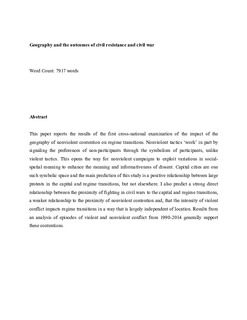Geography and the outcomes of civil resistance and civil war
Journal article, Peer reviewed
Accepted version
Permanent lenke
http://hdl.handle.net/11250/2499064Utgivelsesdato
2017Metadata
Vis full innførselSamlinger
Sammendrag
This paper reports the results of the first cross-national examination of the impact of the geography of nonviolent contention on regime transitions. Nonviolent tactics ‘work’ in part by signalling the preferences of non-participants through the symbolism of participants, unlike violent tactics. This opens the way for nonviolent campaigns to exploit variations in social-spatial meaning to enhance the informativeness of dissent. Capital cities are one such symbolic place and the main prediction of this study is a positive relationship between large protests and regime transitions in the capital, but not elsewhere. I also predict a strong direct relationship between the proximity to the capital of fighting in civil wars, and regime transitions; no relationship to the proximity of nonviolent contention; and that the intensity of violent conflict impacts regime transitions in a way that is largely independent of location. Results from an analysis of episodes of violent and nonviolent conflict from 1990 to 2014 generally support these contentions.
